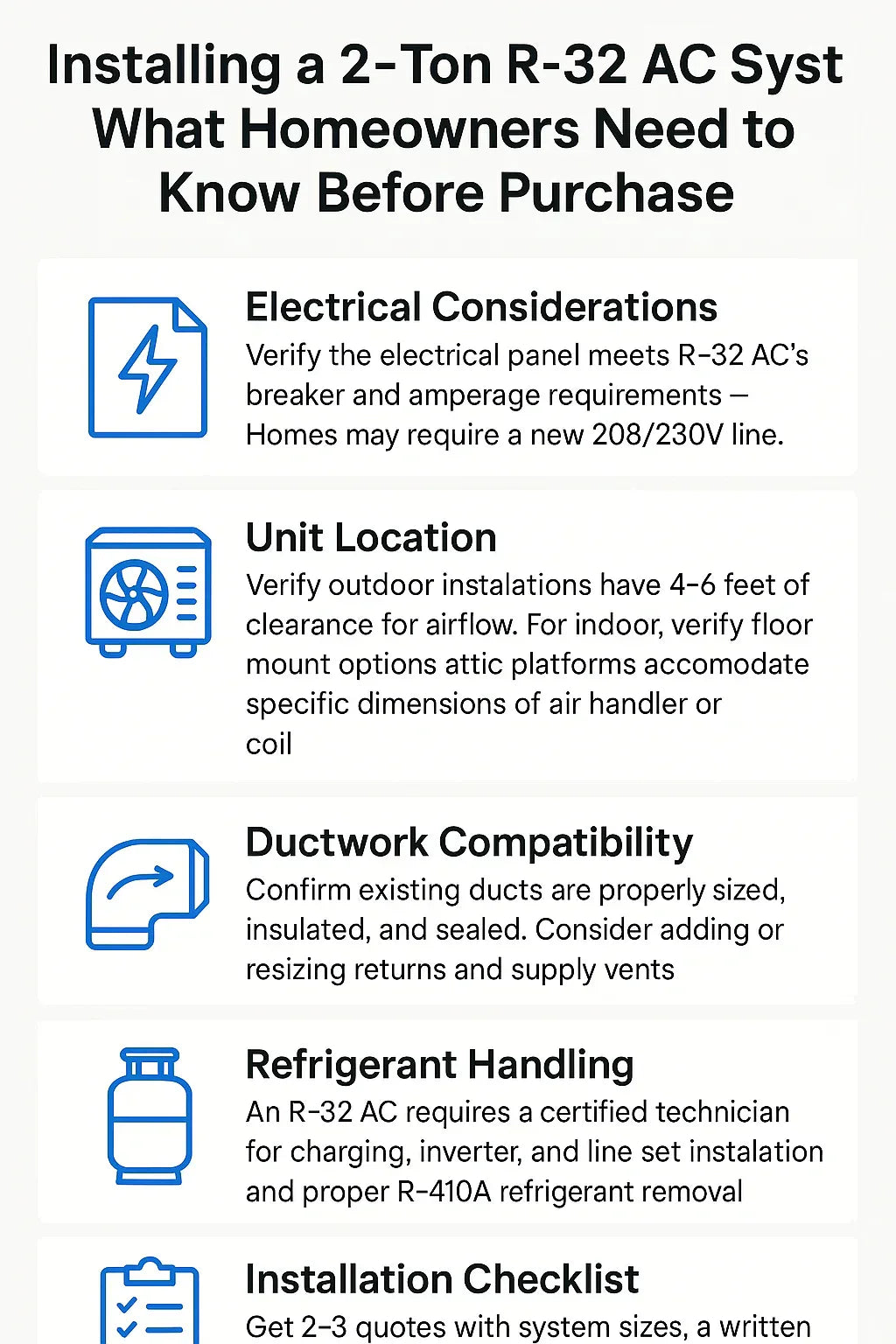🏡 Why It Matters for Mark
Before Mark Callahan invests in a 2-ton R-32 AC system, he needs to understand the installation requirements, potential hidden costs, and compatibility factors to avoid delays and extra expenses. This guide will prepare homeowners to have informed discussions with installers while ensuring a smooth transition to R-32.
📦 What Does a 2-Ton R-32 AC Installation Include?
✅ R-32 outdoor condenser ✅ Indoor evaporator coil or air handler ✅ Line set for refrigerant ✅ Electrical disconnect and wiring ✅ Drain line and safety shutoff ✅ Thermostat (new or existing) ✅ Installation labor and testing ✅ Refrigerant charge (R-32)
🧰 Pre-Installation Checklist
Before booking installation: ✅ Confirm sizing with a Manual J load calculation to ensure a 2-ton system fits your home's needs. ✅ Check your electrical panel capacity (R-32 units may require dedicated circuits). ✅ Inspect ductwork for leaks and sizing compatibility. ✅ Evaluate attic or closet space for the air handler. ✅ Understand local permit requirements and inspection timelines.
Learn more:
⚡ Electrical and Power Requirements
✅ A 2-ton AC typically requires a 20–30 amp breaker. ✅ R-32 systems operate at similar voltages as R-410A (208/230V). ✅ Electrical disconnect may need replacement if outdated. ✅ Surge protection is recommended.
Discuss upgrades with your installer if your panel is near capacity.
🛡️ Refrigerant Line Set Compatibility
While some existing line sets can be reused, many R-32 installs require: ✅ Line flush or replacement due to oil compatibility differences. ✅ Leak testing for older copper lines. ✅ Proper line sizing (3/4" suction, 3/8" liquid typical for 2-ton).
This ensures system reliability and warranty protection.
🌡️ Proper Refrigerant Charging
R-32 systems require precise refrigerant charging for optimal performance: ✅ Digital manifold gauges are recommended. ✅ R-32 requires a lower charge volume than R-410A. ✅ Installers should have A2L refrigerant certification.
Incorrect charging can lead to reduced efficiency or system failure.
🏠 Space and Clearance Requirements
R-32 condensers require:
✅ At least 12–18 inches of clearance on all sides.
✅ 60 inches clearance above for airflow.
✅ Solid, level pad installation.
Air handlers should be installed with sufficient clearance for maintenance access.
🏷️ Permit and Inspection Requirements
✅ Many municipalities require a mechanical permit for AC installation.
✅ Electrical inspections may be required.
✅ Permit fees typically range from $100–$500 depending on your location.
Your installer should handle permits and schedule inspections.
💸 Potential Additional Costs
Prepare for: ❌ Electrical panel upgrades ($800–$2,500) ❌ Line set replacement ($300–$1,000) ❌ Ductwork repairs or sealing ($500–$2,000) ❌ Surge protection ($150–$300) ❌ Permit and inspection fees ($100–$500) ❌ Smart thermostat upgrade ($150–$400)
🧑🔧 Choosing the Right Installer
✅ Look for licensed, insured HVAC professionals with R-32 handling certification. ✅ Ask about experience with R-32 systems. ✅ Request a detailed written estimate. ✅ Check warranty and post-installation support options. ✅ Confirm availability of maintenance plans.
✅ Key Takeaways
-
Perform a Manual J load calculation before purchasing.
-
Ensure your electrical panel and ductwork are ready.
-
Be aware of permit and inspection requirements.
-
Use a qualified installer familiar with R-32 refrigerant.
-
Budget for potential additional costs to avoid surprises.
👉 Ready to Start Your Project?
View R-32 AC and Gas Furnaces – 2 Ton Collection
In the next topic we will know more about: Maintaining Your 2-Ton R-32 AC and Furnace System for Long-Term Performance







